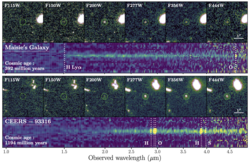Astronomy:Maisie's Galaxy
From HandWiki
| Maisie's Galaxy | |
|---|---|
 Maisie’s Galaxy and CEERS-93316 shown at six infrared wavelengths, with small circles highlighting each object. | |
| Observation data (J2000 epoch) | |
| Right ascension | 214.943153 |
| Declination | 52.942442 |
| Redshift | 14.3 |
| Other designations | |
| CEERS J141946.36+525632.8, [HOO2023] CR2-z12-1 | |
Maisie's Galaxy (also known as CEERS J141946.36+525632.8) is a distant galaxy located at z=14.3 that existed 390 million years after the beginning of the universe.
Background
Discovered in 2022 using the James Webb Space Telescope (JWST) in the CEERS field, Maisie's Galaxy has high star formation rates.[1][2] It was named after the nine-year-old daughter of the person who discovered it.[3]
See also
References
- ↑ Lea, Robert (2023-08-17). "James Webb Space Telescope confirms 'Maisie's galaxy' is one of the earliest ever seen" (in en). https://www.space.com/jwst-maisie-galaxy-earliest-observed.
- ↑ "Webb Spots Candidate for Most Distant Known Galaxy" (in en-US). 2022-08-04. https://www.sci.news/astronomy/maisies-galaxy-11066.html.
- ↑ Finkelstein, Steven L.; Bagley, Micaela B.; Haro, Pablo Arrabal; Dickinson, Mark; Ferguson, Henry C.; Kartaltepe, Jeyhan S.; Papovich, Casey; Burgarella, Denis et al. (2022-12-01). "A Long Time Ago in a Galaxy Far, Far Away: A Candidate z ∼ 12 Galaxy in Early JWST CEERS Imaging". The Astrophysical Journal Letters 940 (2): L55. doi:10.3847/2041-8213/ac966e. ISSN 2041-8205. https://iopscience.iop.org/article/10.3847/2041-8213/ac966e.
 |

